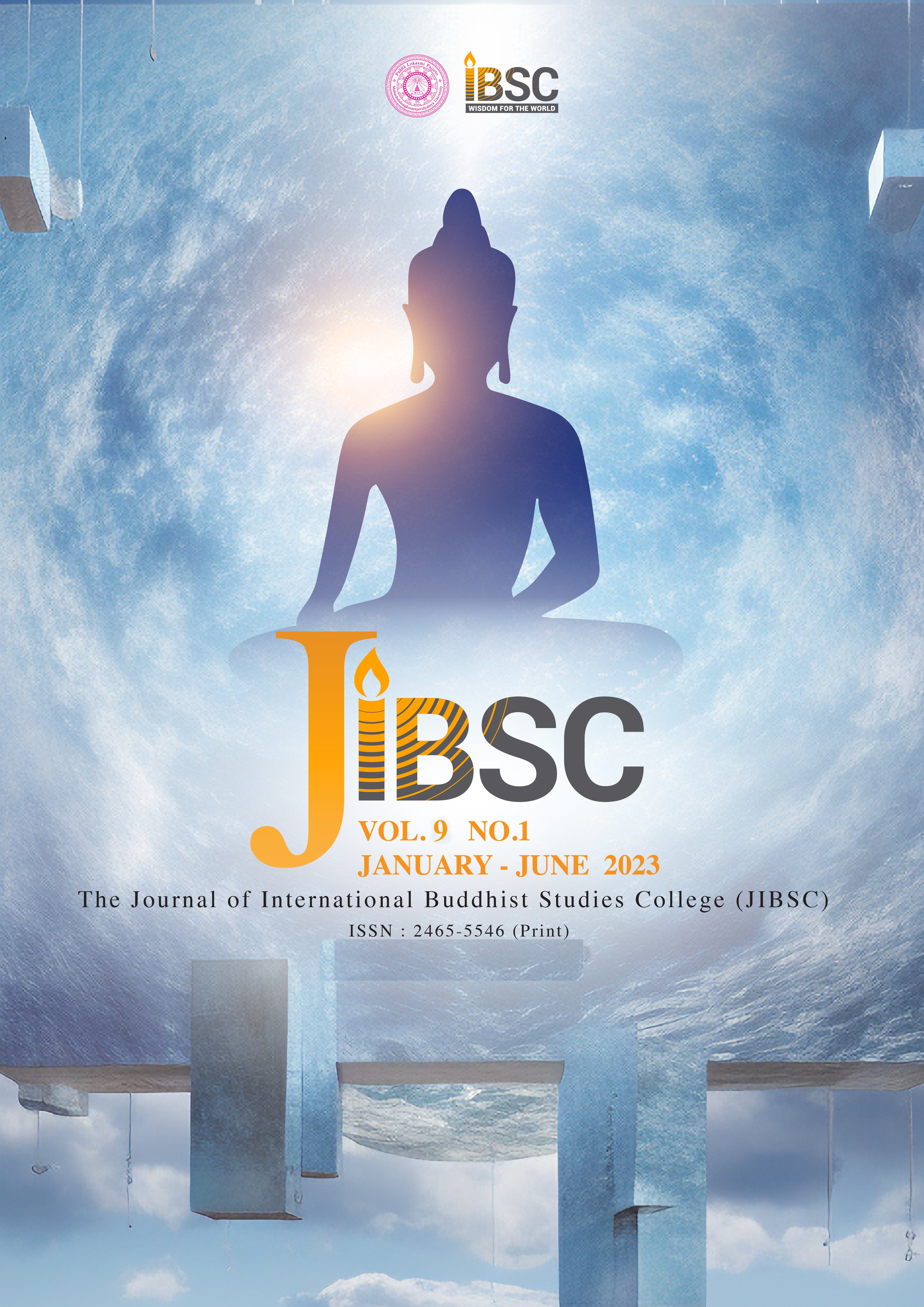An Analytical Study of Phrakrusangworasitthichote’s Educational Administration for Educational Equity among Highlander Youths
Main Article Content
Abstract
Educational Equity is one of the major global obstacles in delaying the achievement of UN’s Sustainable Development Goals (SDGs) by 2030. Like many other countries, Thailand has struggled to successfully bring all of its children into the educational system in an equitable way. While the government cannot render enough quality education services to underprivileged children, Phrapariyattidhamma School can help fill this gap. This study aimed: (1) to survey the status of educational administration at Wat Ban Khun Buddhist School, in Hod district, Chiang Mai Province and (2) to analyze the educational administration for educational equity of the school principal-Phrakrusangworasitthichote. The school is recognized as the leading Buddhist Scripture School in the Northern region rendering equitable basic education and Pāli study to underprivileged highland students since 2003. All students are treated fairly and inclusively. With competent teachers and conducive learning environment, the school has achieved the highest number of students who passed Pāli examination in Chiang Mai. The res
applied a qualitative method and on-site investigation as research design. The research instrument was in-depth interview with 5 key informants utilizing the POSDCoRB theory as the analysis framework for 7 administration aspects, which included Planning, Organizing, Staffing, Directing, Coordination, Reporting and Budgeting. The results suggested that it is essential for school leaders to have a clear understanding and right approaches to cope with inequality in education and ability to orchestrate the staff, villagers, and local authorities to be voluntarily involved in the process of strengthening educational equity.
Article Details
The Journal of TCI is licensed under a Creative Commons Attribution-NonCommercial-NoDerivatives 4.0 International (CC BY-NC-ND 4.0) licence unless otherwise stated. Please read our Policies page for more information on Open Access, copyright and permissions.
References
Chakkaew, Wassana , Katesuda Sitthisantikul, Surachai Kungwon, and Nirote Sinnarong. (2018). "Increasing Opportunities and Accessing to Higher Education for Underprivileged Children in Upper Northern Region." Veridian E-Journal, Silpakorn University 11 (3): 1767-1785.
Chob Kacha-Ananda. (1997). Thailand Yao: Past, Present and Future. Tokyo: Institute for the Study of Languages and Cultures of Asia and Africa.
Fujioka, Rika. (2002). Education Opportunities for hill tribes in northern Thailand. Food and Agriculture Organization of the United Nations.
Regional Office for Asia and the Pacific, (Bangkok: Food and Agriculture Organization of the United Nations Regional Office for Asia and the Pacific). http://www.fao.org/ fileadmin/templates/ERP/2013/link_publications/ak216e00.pdf.
Jaroensorn, Wassana. (2012). "The Efficiency of Educational Management of Subdistrict Administration Organization in Thailand." EAU Herritage Journa, 2 (2): 33-44.
Leydon, Moira. (2018). "UN Sustainable Development Goal 4 - Ensure Inclusive and Equitable Quality Education and Promote Lifelong Learning Opportunities for All." Adult Learner, (0790-8040): 145-148.
National Statistical Office. (2020). "Thailand Population Statistics." Accessed May 11, 2020. http://statbbi.nso.go.th/staticreport/page/sector/en/01.aspx.
Office of Phrapariyattidhamma School Educational Service Area Five. (2016). "Student Statistic in Chiang Mai." Accessed July 30, 2020. https://cutt.ly/Kh2t0WW
Pimchangthong, Rangsan. (2005). "Conditions and problems in education administration general education section of three ecclesiastical schools in sukhothai province." Master Degree, Education Administration, Pibulsongkram Rajabhat University.
Quality Learning Foundation. (2010). Lacking of Educational Opportunity among Thai Youth. QLF Bangkok: QLF).
Shachs, Jeffrey D. (2015). The Age of Sustainable Development. New York: Columbia University Press.
Tang, Qian. (2015). "Goal 4: Ensure inclusive and equitable quality education and promote lifelong learning opportunities for all." UN Chronicle, March 11, 2015.
UNESCO. (2016). Leving No One Behind Reference. Quebec: UNESCO.
UNICEF. 2009. Thailand Public Expenditure Tracking Survey: PETS. Bangkok: UNICEF.
Unterhalter, Elaine. (2019). "The Many Meanings of Quality Education: Politics of Targets and Indicators in SDG4." Global Policy, 10: 39-51.
Whitburn, Ben, and Vicky Plows. (2017). Inclusive Education : Making Sense of Everyday Practice. Netherlands: Senses Publishers.
Chakkaew, Wassana , Katesuda Sitthisantikul, Surachai Kungwon, and Nirote Sinnarong. (2018). "Increasing Opportunities and Accessing to Higher Education for Underprivileged Children in Upper Northern Region." Veridian E-Journal, Silpakorn University 11 (3): 1767-1785.
Chob Kacha-Ananda. (1997). Thailand Yao: Past, Present and Future. Tokyo: Institute for the Study of Languages and Cultures of Asia and Africa.
Fujioka, Rika. (2002). Education Opportunities for hill tribes in northern Thailand. Food and Agriculture Organization of the United Nations.
Regional Office for Asia and the Pacific, (Bangkok: Food and Agriculture Organization of the United Nations Regional Office for Asia and the Pacific). http://www.fao.org/ fileadmin/templates/ERP/2013/link_publications/ak216e00.pdf.
Jaroensorn, Wassana. (2012). "The Efficiency of Educational Management of Subdistrict Administration Organization in Thailand." EAU Herritage Journa, 2 (2): 33-44.
Leydon, Moira. (2018). "UN Sustainable Development Goal 4 - Ensure Inclusive and Equitable Quality Education and Promote Lifelong Learning Opportunities for All." Adult Learner, (0790-8040): 145-148.
National Statistical Office. (2020). "Thailand Population Statistics." Accessed May 11, 2020. http://statbbi.nso.go.th/staticreport/page/sector/en/01.aspx.
Office of Phrapariyattidhamma School Educational Service Area Five. (2016). "Student Statistic in Chiang Mai." Accessed July 30, 2020. https://cutt.ly/Kh2t0WW
Pimchangthong, Rangsan. (2005). "Conditions and problems in education administration general education section of three ecclesiastical schools in sukhothai province." Master Degree, Education Administration, Pibulsongkram Rajabhat University.
Quality Learning Foundation. (2010). Lacking of Educational Opportunity among Thai Youth. QLF Bangkok: QLF).
Shachs, Jeffrey D. (2015). The Age of Sustainable Development. New York: Columbia University Press.
Tang, Qian. (2015). "Goal 4: Ensure inclusive and equitable quality education and promote lifelong learning opportunities for all." UN Chronicle, March 11, 2015.
UNESCO. (2016). Leving No One Behind Reference. Quebec: UNESCO.
UNICEF. 2009. Thailand Public Expenditure Tracking Survey: PETS. Bangkok: UNICEF.
Unterhalter, Elaine. (2019). "The Many Meanings of Quality Education: Politics of Targets and Indicators in SDG4." Global Policy, 10: 39-51.
Whitburn, Ben, and Vicky Plows. (2017). Inclusive Education : Making Sense of Everyday Practice. Netherlands: Senses Publishers.
Wipatayotin, Apinya. (2018). "Ex-education chief urges reform." Bangkok Post. Accessed December 17, 2020. https://www.bangkokpost.com/thailand/general/1391518/ex-education-chief-urges-reform.


